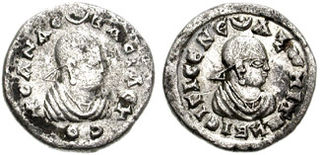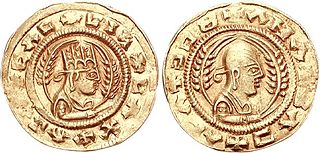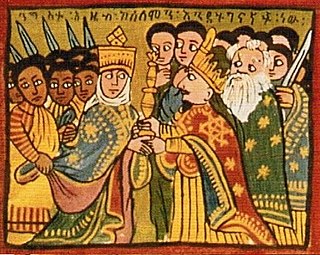Related Research Articles

The emperor of Ethiopia, also known as the Atse, was the hereditary ruler of the Ethiopian Empire, from at least the 13th century until the abolition of the monarchy in 1975. The emperor was the head of state and head of government, with ultimate executive, judicial and legislative power in that country. A National Geographic article from 1965 called Imperial Ethiopia "nominally a constitutional monarchy; in fact it was a benevolent autocracy".

The Church of Our Lady, Mary of Zion is an Ethiopian Orthodox Tewahedo Church which is claimed to contain the Ark of the Covenant.

The Kebra Nagast, var. Kebra Negast, or The Glory of the Kings, is a 14th-century national epic of Ethiopia, written in Geʽez by the nebure id Ishaq of Aksum. In its existing form, the text is at least 700 years old and purports to trace the origins of the Solomonic dynasty, a line of Ethiopian Orthodox Christian monarchs who ruled the country until 1974, to the biblical king, Solomon and the Queen of Sheba. Modern scholarship considers it not to have any historical basis and that its stories were created to legitimize the dynasty's seizure of power in Ethiopia in the 13th century. Nevertheless, many Ethiopian Christians continue to believe it is a historically reliable work.

The Zagwe dynasty was a medieval Agaw monarchy that ruled the northern parts of Ethiopia and Eritrea. The Agaw are a Cushitic ethnic group native to the northern highlands of Ethiopia and neighboring Eritrea. It ruled large parts of the territory from approximately 1137 to 1270 AD, when the last Zagwe King Za-Ilmaknun was killed in battle by the forces of the Amhara King Yekuno Amlak. The Zagwe are most famous for their king Gebre Meskel Lalibela, who is credited with having ordered the construction of the rock-hewn monolithic churches of Lalibela.
Five men known as sons of Yagbe'u Seyon ruled as Emperor of Ethiopia in succession between 1294 and 1299. Their names were:

Tekle Giyorgis I, throne name Feqr Sagad, was Emperor of Ethiopia intermittently between 20 July 1779 and June 1800, and a member of the Solomonic dynasty. He was the youngest son of Yohannes II and Woizoro Sancheviyer, and the brother of Tekle Haymanot II.

Kaleb, also known as Elesbaan, was King of Aksum, which was situated in what is now Ethiopia and Eritrea.

Ousanas was a King of Axum. Stuart Munro-Hay believes that it is "very likely" that Ousanas is the king to whom Aedesius and Frumentius were brought. In Eritrean and Ethiopian tradition, this king is called Ella Allada or Ella Amida. Ella Amida would then be his throne name, although Ousanas is the name that appears on his coins. If this identification is correct, then it was during his reign that Christianity was introduced to Axum and the surrounding territories.
Mara Takla Haymanot was King and the founder of the Zagwe dynasty. Some king lists give his name simply as "Mararah", and other King Lists as "Takla Haymanot".
Dil Na'od was the last King of Aksum before the Zagwe dynasty. He lived in either the 9th or 10th century. Dil Na'od was the younger son of Ged'a Jan, and succeeded his older brother 'Anbasa Wedem as negus. According to E. A. Wallis Budge, "The reign of Delna'ad was short, perhaps about ten years." However, James Bruce has recorded another tradition, that Dil Na'od was an infant when Gudit slaughtered the princes imprisoned at Debre Damo, his relatives, and forced some of his nobles to take him out of his kingdom to save his life.
Degna Djan was an Emperor of the Kingdom of Aksum. Paul B. Henze states that his throne name was "'Anbasa Wedem", which tradition states was his oldest son's name. His younger son was Dil Na'od.

The Kingdom of Aksum also known as the Kingdom of Axum, or the Aksumite Empire, was a kingdom in East Africa and South Arabia from classical antiquity to the Middle Ages, based in what is now northern Ethiopia and Eritrea, and spanning present-day Djibouti and Sudan. Emerging from the earlier Dʿmt civilization, the kingdom was founded in 1st century. The city of Axum served as the kingdom's capital for many centuries until it relocated to Kubar in the 9th century due to declining trade connections and recurring external invasions.
Manuel João Mendes Silva Ramos is a Portuguese anthropologist, artist and civil rights advocate. As an author, he is widely held in libraries worldwide.

The 1922 regnal list of Ethiopia is an official regnal list used by the Ethiopian monarchy which names over 300 monarchs across six millennia. The list is partially inspired by older Ethiopian regnal lists and chronicles, but is notable for additional monarchs who ruled Nubia, which was known as Aethiopia in ancient times. Also included are various figures from Greek mythology and the Biblical canon who were known to be "Aethiopian", as well as figures who originated from Egyptian sources.
Regnal lists of Ethiopia are recorded lists of monarchs who are claimed by tradition to have ruled Ethiopia. These lists are often recorded on manuscripts or orally by monasteries and have been passed down over the centuries.
Bazen was a king of Axum who reigned beginning in 8 B.C. according to various Ethiopian regnal lists in E.C. and around 1 B.C.-16 A.D in G.E..

Gebre Meskel also known as Gabra Masqal was a King of Axum who reigned in the 6th century. He was a son of Kaleb of Axum and brother to Israel of Axum. His reign is most notable for the compositions of hymns by the Ethiopian saint Yared.
Wedem Asfare or Wudme Asfare is the name of a king who appears on various Axumite king lists. His exact reign dates are unknown, but he is believed by some historians to have reigned from the end of the 8th century to the early 9th century.
References
- 1 2 Molvaer, Reidulf K. (1998). "The Defiance of the Tenth-Century Empress Yodït (Judith) of Ethiopia from an Unpublished Manuscript by Aleqa Teklé (Tekle-Ïyesus) of Gojjam". Northeast African Studies. 5 (1): 52f. JSTOR 41931182.
- ↑ Páez, Pedro (2008). Isabel Boavida; Hervé Pennec; Manuel João Ramos (eds.). História da Etiópia (in Portuguese). Assirio & Alvim. p. 105.
- ↑ Páez, Pedro (2008). Isabel Boavida; Hervé Pennec; Manuel João Ramos (eds.). História da Etiópia (in Portuguese). Assirio & Alvim. p. 109.
- ↑ Budge, E. A. (1928). A History of Ethiopia: Nubia and Abyssinia (Volume I). London: Methuen & Co. Ltd. p. 211.
- ↑ Salt, Henry (1814). A Voyage to Abyssinia. London. p. 472.
- 1 2 Budge, E. A. (1928). A History of Ethiopia: Nubia and Abyssinia (Volume I). London: Methuen & Co. Ltd. p. 211.
- 1 2 3 Rey, C. F. (1927). In the Country of the Blue Nile. London: Camelot Press. pp. 270–271.
- ↑ Truhart, Peter (1984). Regents of Nations (Part 1). Munich: K. G. Saur. p. 102. ISBN 3-598-10492-8.
- ↑ Matthews, Derek; Mordini, Antonio (1959). "The Monastery of Debra Damo, Ethiopia" (PDF). Archaeologia. 97: 30. doi:10.1017/S0261340900009930 – via Cambridge Core.
- ↑ Dillmann, August (1853). "Zur Geschichte des abyssinischen Reichs". Zeitschrift der Deutschen Morgenländischen Gesellschaft (in German). 7: 349.
- 1 2 Selassie, Sergew Hable (1972b). "The Problem of Gudit". Journal of Ethiopian Studies. 10 (1): 115. ISSN 0304-2243. JSTOR 41965849.